Q2. Define asexual reproduction. Describe the different methods of asexual reproduction.
Answer:
Definition
Asexual reproduction is simple cell division that produces an exact duplicate of an organism. It does not involve the fusion of gametes.
Types of Asexual Reproduction
There are many types of asexual reproduction, they produce individuals that are genetically identical to each other and to the parent.
(1) Binary fission
(a) Introduction
Binary fission means “division into two”, it is the simplest and most common method of asexual reproduction.
(b) Occurrence
Binary fission occurs in prokaryotes (Bacteria), many unicellular eukaryotes e.g. protozoa and some invertebrates.
(c) Examples
(1) Binary Fission in Bacteria
(i) During binary fission in bacteria, the DNA is duplicated and so two copies of DNA are formed.
(ii) The two copies move towards the opposite poles of the cell.”
(iii) The cell membrane invaginates in centre and divides the cytoplasm into two.
(iv) New cell wall is deposited between the two cross walls. It results in the formation of two
daughter bacteria, which grow in size and divides again.

(ii) Binary fission in unicellular Eukaryotes (Amoeba)
It occurs in the following way:
(i)The nucleus of parent organism divides into two by mitosis.
(ii) It is followed by the division of cytoplasm.
(iii) So two daughter cells of almost equal size are formed.
(iv) Daughter cells grow in size and then divide again.
(iii) Binary fission in invertebrates
During this asexual reproduction, body is cut into two halves and the missing body parts are regenerated in both halves. e.g., planaria and many echinoderms.
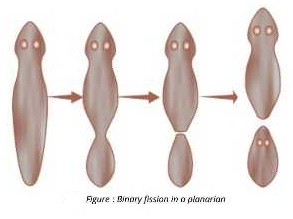
(2) Fragmentation
Introduction
In fragmentation, certain worms grow to full size, they’ spontaneously break up into 8 or 9 pieces. Each piece develops into a mature worm and the process is repeated.
Example
If a planarian breaks into many pieces instead of two, it will also be called as fragmentation.
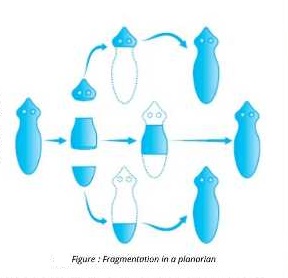
(3) Budding / Explain budding with example.
(a) Definition
In budding, a bud develops as a small outgrowth on parent’s body.
(a) Budding in yeast
(i) In yeast, a small bud is formed on one side of the cell.
(ii) The nucleus of the cell divides and one of the daughter nuclei is passed into the bud.
(iii) Parent cell may form more than one bud at a time.
(iv) Each bud enlarges and may separate from parent body.
(v) In some cases, the buds never separate and as a result, colonies of individuals are formed.
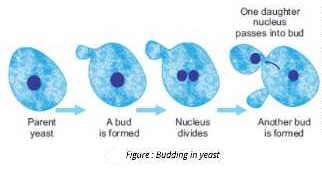
(b) Budding in sponges, hydra and corals
(i) A small bud is formed on the side of bodies of these organisms, by mitosis.
(ii) This bud enlarges by the formation of more cells.
(iii) It then detaches from the parent body and grows into new organisms in hydra. But in corals, the buds do not detach and form big colonies.

4. Spore formation
(a) Introduction
It is generally seen in most fungi.
(b) Examples
(i) Spore formation in Rhizopus
When Rhizopus reaches the reproductive age, its body cells form thick walled spore sacs called sporangia (sing: sporangium). Inside each sporangium, a cell divides many times and forms many daughter cells, called spores. Each spore is covered by a thick wall called cyst and it survive unfavourable conditions. When sporangia mature, they burst and release spores. Under favourable conditions, the spores germinate and develop into new Rhizopus.
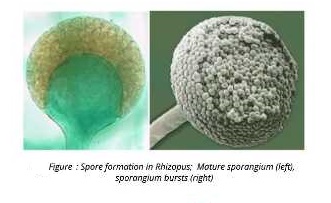
(ii) Endospore Formation in bacteria
Under unfavourable conditions, some species of bacteria reproduce by forming spores, e.g.. Clostridium and Bacillus species. Thick walled spores are formed inside bacterial cells. They are called endospores.
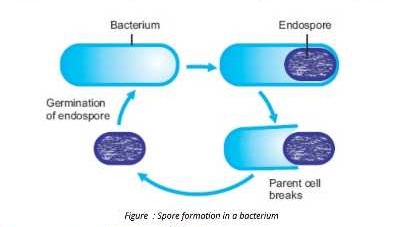
5- Parthenogenesis :
Definition
It is also a form of asexual reproduction. In it, an unfertilized egg develops into new offspring.
Examples
(i) Some fishes, frogs and insects reproduce by means of parthenogenesis.
(ii) Parthenogenesis in Honeybee
Queen honeybee Jays eggs in the cells of honeycomb. Many eggs remain unfertilized and develop into haploid males (drones) by parthenogenesis and eggs that are fertilized by male bees develop into diploid females.
6- Vegetative Propagation
Definition
The process in which vegetative parts of plants i.e. roots, stems or leaves give rise to new plant is called vegetative propagation.
Occurrence
It occurs naturally and artificially.
(1) Natural Vegetative Propagation :
It occurs naturally in several ways.
(i) Bulbs
Definition
Bulbs are short underground stems surrounded by thick, fleshy leaves that contain stored food. Explanation
Adventitious roots arise from the base of bulb while shoots arise from the top of the base.
Examples:
Tulips, onions and lilies reproduce by bulbs
(ii) Corms
Introduction
Corms are short and swollen underground stems containing stored food.
Explanation
Buds are present at the top of corm. Shoot grows from a bud and forms a new plant.
Examples
Dasheen and garlic :
(iii) Rhizomes
Introduction
These are horizontal underground stems with scale leaves. ”
Explanation
Enlarged portions on rhizome are called nodes. Buds are produced at nodes which give rise to shoot. The lower surface of rhizome produces adventitious roots.
Examples
Ginger, ferns and water lilies reproduce by rhizomes.
(iv) Stem Tubers
Definition
These are the enlarged portions of an underground stem (rhizome).
Explanation
There are aggregations of tiny buds in the form of “eyes” along the surface of tuber. Each bud develops into shoot that grows upward and also produces roots.
Examples
Potatoes and Yams
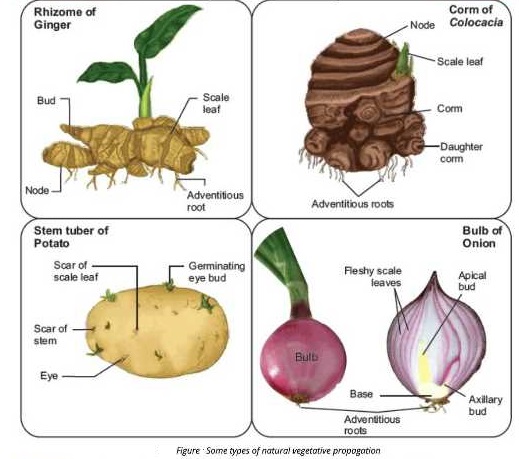
(v) Suckers Definition
Suckers are lateral stems close to ground level.
Explanation
A sucker grows underground from some distance and then turn up, producing the new plant.
Example
Mint and chrysanthemum
(vi) By Leaves
Introduction
Vegetative propagation by leaves is not common and is seen in plants such as Bryophyllum (Pather Chut).
Explanation
This plants has fleshy leaves and adventitious buds are present at the margins of leaves. When leaf falls on ground, the buds grow into new plants.
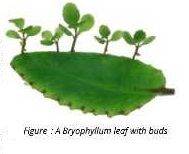
2- Artificial Vegetative Propagation
The following two are the most common methods of artificial vegetative propagation:
(i) Cuttings
Introduction
In this method, cuttings may be taken mainly from the stems or roots of parent plant. These cuttings must have a meristematic region from which growth can occur. When cuttings are placed in a suitable soil (sufficient nutrients, water and sunlight), they form roots and shoots which develop into a new plant identical to parent.
Examples
Stem Cuttings
Roses, ivy, grapevines, and sugarcane
Root Cuttings
Sweet potato is an enlarged root. Farmers place it in moist sand or soil until it produces several plantlets. Then the plantlets are removed and planted. This process is used to produce many plants from a single plant and all plants are same. This method has been very beneficial on sugarcane plantation
(ii) Grafting
Introduction
In grafting, a piece of stem is cut from the plant and is attached with another plant with established root system. After a while, the vascular bundles of the attached stem piece and the host plant are connected to each other. The stem piece and the plant begin to grow together.
Examples:
Roses, peach trees, plum trees and grapes.

![]()